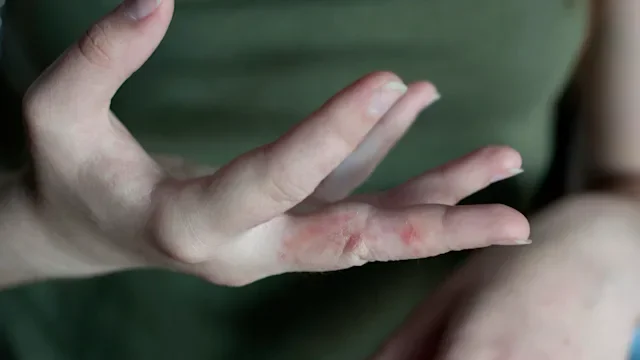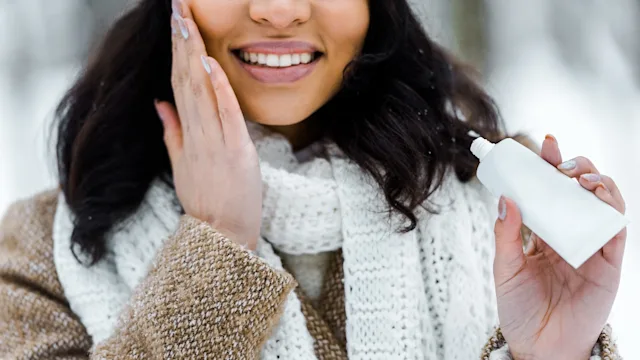Key takeaways:
Chafing is a common, often painful skin issue that happens when skin rubs against clothing or another part of your skin.
You can prevent chafing by wearing moisture-wicking clothes, using petroleum jelly to lessen friction, and protecting chafe-prone areas with bandages.
If you’re already chafed, change your activity and keep the area clean until it heals.
Whether you’re an athlete or someone who enjoys being active, chances are you’ve dealt with the uncomfortable and sometimes painful issue of skin chafing. This problem occurs when skin rubs against skin or fabric. With continuous rubbing, your skin may sting, and you may see redness or a mild rash.
Areas where skin rubs together, like the thighs, groin, and underarms, are commonly prone to chafing. And constant chafing can cause painful blisters and even infection if left untreated. So what can you do?
How do you prevent chafing?
The best way to manage chafing is to prevent it from happening in the first place. There are a number of steps you can take to do this.
Search and compare options
1. Choose the appropriate clothing
To prevent chafing, it’s important to pay attention to what you’re wearing. Your clothes can cause chafing by continuously rubbing against your skin.
When exercising, make sure your workout gear fits properly and is made of moisture-wicking materials like synthetic fibers. These fabrics are designed to absorb sweat and dry quickly. You’ll want to steer clear of cotton, as it tends to trap moisture and can cause irritation.
Compression shorts also work great to prevent thigh and groin chafing, especially for activities like cycling.
If you’re working out outside in warm weather, try wearing less clothing to reduce the risk of chafing. But make sure to protect your skin from the sun’s harmful rays by staying in the shade as much as possible and using sunscreen.
2. Lubricate problem areas
Since friction is a culprit, reducing friction is a good way to prevent chafing. You can do this by using lubrication on problem areas most likely to rub together.
Petroleum jelly is an inexpensive and easy-to-find lubricant. But you can find other anti-chafing products over the counter. Start by applying the lubricant to areas where your skin rubs together or against clothing. You may need to reapply during long workouts to ensure continued protection.
Read more like this
Explore these related articles, suggested for readers like you.
3. Wear seamless clothes
Clothing with bulky or rough seams can rub on your skin with repeated movement and cause irritation. The same is true for clothes with tags in areas that can cause friction. Opt for exercise clothes that are seamless and have no tags, especially in areas that are prone to chafing.
For example, it’s best to wear biking shorts with no seams in the inner thigh for cycling. Bra underwires can poke into your sides and rub against your skin, leading to redness and irritation. If you’re experiencing this issue, consider wearing a wireless sports bra.
4. Get out of wet clothes
While sweat helps cool you down when you exercise, it can also lead to chafing. This happens when moisture is mixed with friction from your clothing or skin.
To prevent chafing caused by sweat, dry off your skin regularly, especially if you’re outside in high heat and humidity. Avoid sitting around in wet or sweaty clothes. Instead, try to shower immediately after you sweat and change into clean, dry clothing. Staying dry reduces the likelihood of chafing caused by sweat and moisture.
5. Take care of your thighs
The skin on your inner thighs is highly susceptible to chafing. When your thighs rub against each other, it can cause friction that may irritate the skin. Inner-thigh chafing is most likely to occur in warm weather. But it doesn’t have to put a damper on your summer wardrobe.
Anti-chafing shorts can be a great solution if you’re prone to inner-thigh chafing. Choose shorts that are seamless and long enough to cover chafe-prone areas. If you prefer running skirts, opt for those with built-in shorts. But make sure they are made of a breathable, quick-dry material.
Alternatively, use anti-chafing sticks that are specially formulated with lubricants. They are easy to use and create a barrier between your skin, which helps to lessen friction and chafing. A moisture-absorbing powder, such as cornstarch, is also a good alternative to keep your skin from chafing.
6. Protect chafe-prone areas
Bandages can add an extra layer of protection and prevent chafing. Soft, flexible bandages, such as adhesive moleskin, can be applied to problem areas like your feet and thighs.
The bandage acts as a second skin, preventing friction and reducing the likelihood of irritation or blisters. It’s important to apply the bandages securely to keep them from moving around and causing further irritation.
7. Consider your footwear
Shoes that lack cushioning or don’t fit properly can cause friction, leading to chafing.
When working out, wear well-fitting shoes to prevent foot chafing. You can add extra cushioning to your shoes by placing moleskin in chafe-prone areas. A good idea is to get fitted for your exercise footwear at an athletic store to make sure your shoes fit properly.
In addition to friction, foot moisture plays a big role in the formation of chafing. So, whether you’re working out or doing your day-to-day activities, choose the right socks to keep your feet dry. Moisture-wicking socks are great choices to avoid sweaty feet and chafing.
How do you treat chafing?
If you’re starting to chafe during an activity, stop the activity immediately. Prolonged friction can turn a chafed spot into a blister, and these areas can potentially get infected.
If you’re already chafed, try these self-care measures to treat it:
Clean the area. Before treating chafed skin, make sure to clean the area thoroughly with mild soap and water. Gently pat the area dry with a clean towel.
Use a moisturizer. With clean hands, apply petroleum jelly or other moisturizers to protect the skin from further chafing.
Wear loose clothing. Tight clothes can make a chafed area worse. Instead, opt for loose, breathable clothing until the affected area has healed. For chafing on your feet, it’s a good idea to wear sandals until it’s completely healed.Change activity. If chafing was caused by physical activity, take a break from that activity until the area has healed. This will give the skin time to recover and reduce the risk of further irritation.
Seek medical attention for severe chafing that’s not healing or if you notice signs of infection such as:
Increased redness
Swelling
Hot skin
Pus
Pain that’s getting worse
Your healthcare provider can prescribe medication or recommend additional treatment options to help the healing process.
How long does chafing take to heal?
Chafing may take a few days to heal. Generally the chafed area should scab over within a couple of days, and the scabs should fall off on their own within a week. Remember to keep the chafed area clean to prevent an infection.
Plan to continue to avoid the activity that caused the chafing until the area is healed. Protect the chafed spot from further irritation, and wear clothing that will not rub on the affected area.
The bottom line
Chafing can be a painful and uncomfortable experience caused by friction between skin and clothing or from different parts of your skin rubbing together. But chafing doesn’t have to ruin your plans and limit your activities.
Prevent chafing by wearing well-fitting clothing made of breathable fabric, protecting susceptible areas with a lubricant or anti-chafing stick, and keeping your skin dry.
If you have already developed chafing, avoid the activity that caused it, and keep the area clean and protected. It should scab over and heal in a few days.

Why trust our experts?



References
American Academy of Dermatology Association. (n.d.). How to prevent and treat blisters.
American Academy of Dermatology Association. (2021). How your workout can affect your skin.
D’Souza, B., et al. (2021). A brief review on factors affecting the tribological interaction between human skin and different textile materials. Materials.
MacFarlane, M. J., et al. (2021). Skin tribology in sport. Biosurface and Biotribology.
Mailler, E. A., et al. (2004). The wear and tear of 26.2: Dermatological injuries reported on marathon day. British Journal of Sports Medicine.















